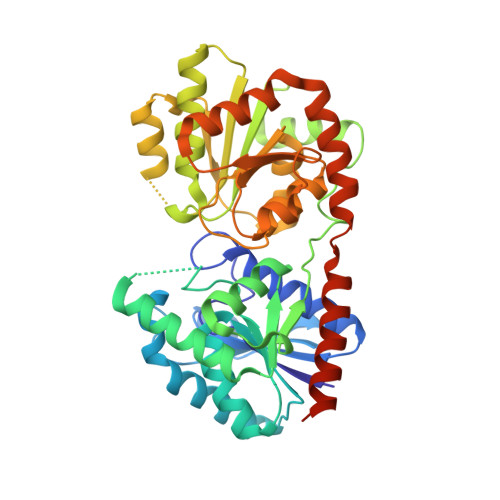Structural and Enzymatic Analysis of MshA from Corynebacterium glutamicum: SUBSTRATE-ASSISTED CATALYSIS
Vetting, M.W., Frantom, P.A., Blanchard, J.S.(2008) J Biol Chem 283: 15834-15844
- PubMed: 18390549
- DOI: https://doi.org/10.1074/jbc.M801017200
- Primary Citation of Related Structures:
3C48, 3C4Q, 3C4V - PubMed Abstract:
The glycosyltransferase termed MshA catalyzes the transfer of N-acetylglucosamine from UDP-N-acetylglucosamine to 1-L-myo-inositol-1-phosphate in the first committed step of mycothiol biosynthesis. The structure of MshA from Corynebacterium glutamicum was determined both in the absence of substrates and in a complex with UDP and 1-L-myo-inositol-1-phosphate. MshA belongs to the GT-B structural family whose members have a two-domain structure with both domains exhibiting a Rossman-type fold. Binding of the donor sugar to the C-terminal domain produces a 97 degrees rotational reorientation of the N-terminal domain relative to the C-terminal domain, clamping down on UDP and generating the binding site for 1-L-myo-inositol-1-phosphate. The structure highlights the residues important in binding of UDP-N-acetylglucosamine and 1-L-myo-inositol-1-phosphate. Molecular models of the ternary complex suggest a mechanism in which the beta-phosphate of the substrate, UDP-N-acetylglucosamine, promotes the nucleophilic attack of the 3-hydroxyl group of 1-L-myo-inositol-1-phosphate while at the same time promoting the cleavage of the sugar nucleotide bond.
Organizational Affiliation:
Department of Biochemistry, Albert Einstein College of Medicine, Bronx, New York 10461, USA. vetting@aecom.yu.edu

















